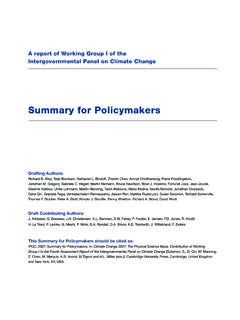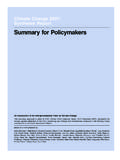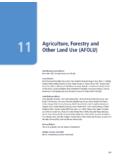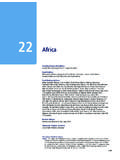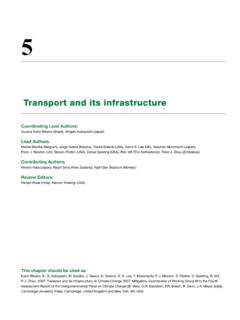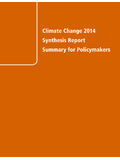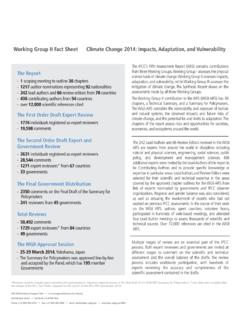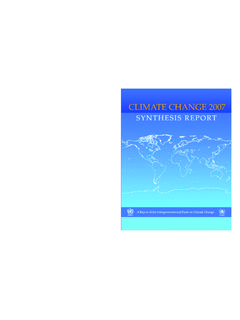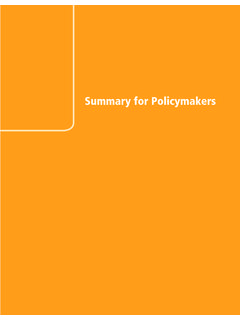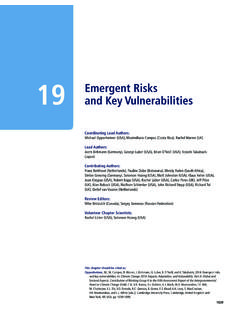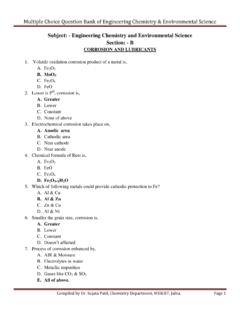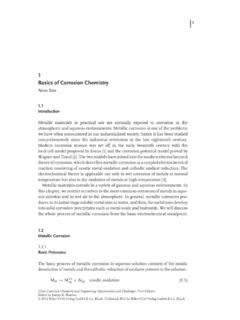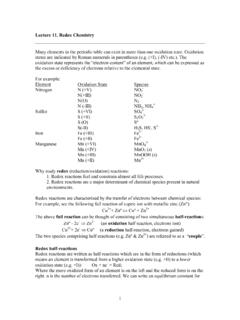Transcription of The Carbon Cycle and Atmospheric Carbon Dioxide - IPCC
1 3. The Carbon Cycle and Atmospheric Carbon Dioxide Co-ordinating Lead Author Prentice Lead Authors Farquhar, Fasham, Goulden, M. Heimann, Jaramillo, Kheshgi, C. Le Qu r , Scholes, Wallace Contributing Authors D. Archer, Ashmore, O. Aumont, D. Baker, M. Battle, M. Bender, Bopp, P. Bousquet, K. Caldeira, P. Ciais, Cox, W. Cramer, F. Dentener, Enting, Field, P. Friedlingstein, Holland, Houghton, House, A. Ishida, Jain, Janssens, F. Joos, T. Kaminski, Keeling, Keeling, Kicklighter, Kohfeld, W. Knorr, R. Law, T. Lenton, K. Lindsay, E. Maier-Reimer, Manning, Matear, McGuire, Melillo, R.
2 Meyer, M. Mund, Orr, S. Piper, K. Plattner, Rayner, S. Sitch, R. Slater, S. Taguchi, Tans, Tian, Weirig, T. Whorf, A. Yool Review Editors L. Pitelka, A. Ramirez Rojas Contents Executive Summary 185 Interannual Variability in the Rate of Atmospheric CO2 Increase 208. Introduction 187 Inverse Modelling of Carbon Sources and Sinks 210. Terrestrial and Ocean Biogeochemistry: Terrestrial Biomass Inventories 212. Update on Processes 191. Overview of the Carbon Cycle 191 Carbon Cycle Model Evaluation 213. Terrestrial Carbon Processes 191 Terrestrial and Ocean Biogeochemistry Background 191 Models 213.
3 Effects of changes in land use and Evaluation of Terrestrial Models 214. land management 193 Natural Carbon cycling on land 214. Effects of climate 194 Uptake and release of Effects of increasing Atmospheric anthropogenic CO2 by the land 215. CO2 195 Evaluation of Ocean Models 216. Effects of anthropogenic nitrogen Natural Carbon cycling in the deposition 196 ocean 216. Additional impacts of changing Uptake of anthropogenic CO2 by Atmospheric chemistry 197 the ocean 216. Additional constraints on terrestrial CO2 uptake 197 Projections of CO2 Concentration and their Ocean Carbon Processes 197 Implications 219.
4 Background 197 Terrestrial Carbon Model Responses to Uptake of anthropogenic CO2 199 Scenarios of Change in CO2 and Climate 219. Future changes in ocean CO2 Ocean Carbon Model Responses to Scenarios uptake 199 of Change in CO2 and Climate 219. Coupled Model Responses and Implications Palaeo CO2 and Natural Changes in the Carbon for Future CO2 Concentrations 221. Cycle 201 Methods for assessing the response Geological History of Atmospheric CO2 201 of Atmospheric CO2 to different Variations in Atmospheric CO2 during emissions pathways and model Glacial/inter-glacial Cycles 202 sensitivities 221.
5 Variations in Atmospheric CO2 during the Concentration projections based on Past 11,000 Years 203 IS92a, for comparison with previous Implications 203 studies 222. SRES scenarios and their implications Anthropogenic Sources of CO2 204 for future CO2 concentration 223. Emissions from Fossil Fuel Burning and Stabilisation scenarios and their Cement Production 204 implications for future CO2. Consequences of Land-use Change 204 emissions 224. Conclusions 224. Observations, Trends and Budgets 205. Atmospheric Measurements and Global References 225.
6 CO2 Budgets 205. The Carbon Cycle and Atmospheric Carbon Dioxide 185. Executive Summary accuracy of these estimates. Comparable data for the 1990s are not yet available. CO2 concentration trends and budgets The land-atmosphere flux estimated from Atmospheric observations comprises the balance of net CO2 release due to Before the Industrial Era, circa 1750, Atmospheric Carbon Dioxide land-use changes and CO2 uptake by terrestrial systems (the (CO2) concentration was 280 10 ppm for several thousand years. residual terrestrial sink ). The residual terrestrial sink is It has risen continuously since then, reaching 367 ppm in 1999.
7 Estimated as PgC/yr (range to + PgC/yr) during the The present Atmospheric CO2 concentration has not been 1980s. It has several likely causes, including changes in land exceeded during the past 420,000 years, and likely not during the management practices and fertilisation effects of increased past 20 million years. The rate of increase over the past century Atmospheric CO2 and nitrogen (N) deposition, leading to is unprecedented, at least during the past 20,000 years. increased vegetation and soil Carbon . The present Atmospheric CO2 increase is caused by anthro- Modelling based on Atmospheric observations (inverse pogenic emissions of CO2.)
8 About three-quarters of these modelling) enables the land-atmosphere and ocean-atmosphere emissions are due to fossil fuel burning. Fossil fuel burning (plus fluxes to be partitioned between broad latitudinal bands. The sites a small contribution from cement production) released on of anthropogenic CO2 uptake in the ocean are not resolved by average PgC/yr during 1980 to 1989, and inverse modelling because of the large, natural background air- PgC/yr during 1990 to 1999. Land use change is responsible for sea fluxes (outgassing in the tropics and uptake in high latitudes).
9 The rest of the emissions. Estimates of the land-atmosphere flux north of 30 N during 1980. The rate of increase of Atmospheric CO2 content was to 1989 range from to PgC/yr; for the tropics, to PgC/yr during 1980 to 1989 and PgC/yr during 1990 + PgC/yr. These results imply substantial terrestrial sinks for to 1999. These rates are less than the emissions, because some of anthropogenic CO2 in the northern extra-tropics, and in the the emitted CO2 dissolves in the oceans, and some is taken up by tropics (to balance deforestation). The pattern for the 1980s terrestrial ecosystems.
10 Individual years show different rates of persisted into the 1990s. increase. For example, 1992 was low ( PgC/yr), and 1998 was Terrestrial Carbon inventory data indicate Carbon sinks in the highest ( PgC/yr) since direct measurements began in northern and tropical forests, consistent with the results of inverse 1957. This variability is mainly caused by variations in land and modelling. ocean uptake. East-west gradients of Atmospheric CO2 concentration are an Statistically, high rates of increase in Atmospheric CO2 have order of magnitude smaller than north-south gradients.
